Locking Horns
As poaching pushes the rhino toward extinction, South Africa considers a radical solution: Legalize the very thing that is killing them. It'd make some people very rich. But would it doom the species?
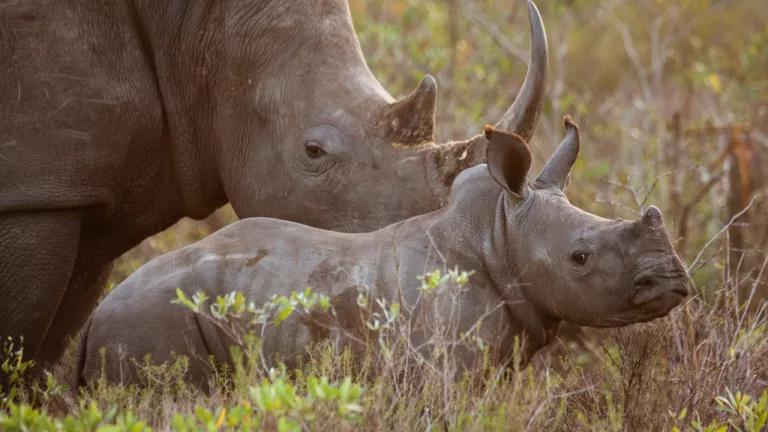
An adult and baby white rhino at Phinda Private Game Reserve in KwaZulu-Natal, South Africa
I was three hours southwest of Johannesburg, driving on an empty dirt road by a tributary of the Vaal River, when the men came into view. There were perhaps ten of them, in groups of two or three, all wearing thick tan overcoats that ran down to their boots and flapped open as they moved, billowing stiffly like heavy wet capes. The sun had been up only a short while, and they walked straight at us through a low morning mist. Strapped across each man’s back, or slung over a shoulder and dangling at his side, was an assault rifle.
The nearest town was several miles off, and the land was mostly flat and stretched away from the road into low bushveld and grazing pastures. Electric fencing ran along the side of the road, about eight feet high. The barricade had a dual purpose: contain large herds of farm-raised rhinos living there—and keep out the humans bent on killing them.
I slowed the car and eased past the men, who nodded as I rolled by. These weren’t poachers, who operate more clandestinely, but a security force walking home after the night shift at a nearby rhino ranch. You could be forgiven for confusing the two. In South Africa’s rhino war—perhaps the greatest ecological threat on the continent—the men facing off on the front lines are alike in far more ways than they’re different. Well armed, largely poor, and almost always black, they are pawns in a conflict that is rapidly destroying the largest rhino population on the planet.
Rhinos are being killed for their horns. Highly sought after in Asia—mostly China and Vietnam—they are both a luxury status symbol and an ingredient in traditional medicines and crackpot potions touted as cures for cancer. The black-market street price can exceed $60,000 per kilogram, more than gold or cocaine.

The skulls of rhinos that were killed by poachers, gathered by an anti-poaching unit at Singita, a private game reserve in the Sabi Sand Reserve
Peter DiCampo
As the animal slides toward extinction, South Africa, home to about 80 percent of the world’s rhinos, is considering a radical and controversial proposition to save them: the legalization of international trade in rhino horn, which has been banned since 1977 by the Convention on International Trade in Endangered Species of Wild Fauna and Flora, known as CITES.
In 2014, 1,215 rhinos were poached in South Africa—a stark contrast to just 13 in 2007. And this year, according to government officials, 749 animals were lost by the end of August—33 more than were killed over the same eight months of 2014, meaning a record high will almost certainly be reached again this year.
Proponents of legalization contend that a trade system would allow supply and demand to be controlled in a way that will keep prices high enough to provide substantial revenue to boost security. Critics, to say the least, are skeptical, pointing out that, among other things, high prices will continue to lure poachers. The South African government, which had seemed to be favoring the idea, has taken a step back in recent months, contemplating its position as it hears from experts and the public on the matter.
A recommendation from the country’s leaders is expected soon, but the final approval would have to made by CITES at the next voting conference, which will be held September 24 through October 5, 2016, in Johannesburg.
The legalization proposal—which has been called a “desperate gamble” by Julian Rademeyer, author of Killing for Profit, the definitive book on the illegal rhino horn trade—began gathering momentum several years ago, championed by a small group of rhino farmers. In South Africa, where wildlife can be owned, it’s not uncommon for people—largely white and wealthy landowners—to turn big tracts of acreage into private game reserves to attract safari tourists. A smaller number of people run private ranches to breed and raise non-endangered animals like buffalo or antelope. And some are raising rhinos as well. Not only can rhinos adapt to ranching, but their horns (made of keratin, like fingernails) grow back after being cut off, meaning they can be harvested.
As poaching has soared, so has the animals’ value, and some of these rhino farmers saw an opportunity to help preserve wildlife as well as start a lucrative business.
The black-market street price for rhino horn can exceed $60,000 per kilogram, more than gold or cocaine.
Trade supporters see horn harvesting as akin to milking cows or shearing wool from sheep. Farmers breed and raise the rhinos, storing the horns in hopes that legalization will be passed so they can sell their haul for a healthy profit, even after covering their substantial farming and security costs. The animals themselves are also for sale, usually to game reserves or zoos, but that doesn’t yield as much revenue as the horns would.
Critics compare the dangers of the rhino horn trade to the demand for elephant ivory, which jumped following the release of ivory stockpiles and led to more poaching, further threatening the elephant population. Some legalization opponents don’t believe rhino farmers have the animal’s best interests at heart, noting that if trade is allowed, they stand to make many millions of dollars. Others worry that the much-beleaguered South African government is also motivated by the potential windfall rather than by the common good.
Meanwhile, profiteering and rancor reign. Fear of poachers and the criminal syndicates that fund them has been a boon for the security industry, while companies selling everything from business supplies to car-rental services use the rhino’s likeness to burnish their image. Conservationists have turned against each other, nonprofits with “donate here” buttons for anti-poaching efforts on their websites are proliferating, and distrust between the majority black population and white minority is deepening.
None of this is doing anything to help the lumbering rhino, whose numbers continue to plummet as the demand for horn soars. There are thought to be about 20,000 white rhinos left in Africa and 4,000 black rhinos. If poaching rates continue to climb, some experts worry that in 10 years, all wild black rhinos will be gone, which would mean it wouldn't be long until the white rhino meets the same fate.
* * *

White rhinos at Buffalo Dream Ranch, South Africa
Peter DiCampo
A few minutes after driving past the armed off-duty guards, I turned through the gates of the Buffalo Dream Ranch, home to more than 1,100 rhinos. The ranch, which is not open to the public, is a patchwork of about 27 square miles of land—about the size of Manhattan. John Hume, its outspoken owner, is a 73-year-old native of South Africa who grew up in Rhodesia before the country became Zimbabwe. He raises other animals, but he is chiefly a rhino breeder and by far the biggest in the country. The Buffalo Dream Ranch, in fact, is the largest private rhino farm in the world.

John Hume owns Buffalo Dream Ranch, the largest private rhino farm in the world.
Peter DiCampo
Hume has a deep rattle of a voice and an unruly gray beard that runs down his neck. He was in a foul mood. The men I’d seen on the road were part of a security force that was supposed to be protecting his herd, but it was not living up to his expectations. The previous week, four of his rhinos had been poached. “They came in here, shot two rhinos here and two here,” he said, pointing to a map of his ranch on the wall. “Three adult cows and one calf. Hacked off the horns and came out the same way. Security didn’t hear the shots. How the hell that’s possible I don’t know.”
With the new killings, 10 rhinos had now been poached on Hume’s ranch over the prior year. In the yard outside his office sat half a dozen men, one of several groups Hume was subjecting to polygraphs to see if it was an inside job.
Security is far and away Hume’s biggest expense, and he insists that legalized horn is the only way to cover his costs. “If you are anti-legal trade, then you are the enemy of my rhino—because that is the biggest reason why my rhinos will go extinct,” he said. “Without us being able to sell the horns, this project will fail. The costs are insurmountable.”
“Western civilization doesn’t understand the problem. They just think, Oh, it’s wrong to cut off a rhino’s horn, and there’s no right way to do a wrong thing,” Hume continued. “The East will find horn to buy. And if we refuse them as we are now, they’ll just buy it illegally—which means the rhinos will get poached.”
One of Hume’s allies is Michael Eustace, a former investment banker whose writing in support of legalization has made him a leader of the pro-trade movement, though he doesn’t share Hume’s belief that bolstering security is a prime reason for the proposal. Despite the piles of money being spent on security, Eustace pointed out, it isn’t fixing the problem—the solution, he said, is to have a properly organized trade.

Former investment banker Michael Eustace is a proponent of legalizing the rhino horn trade.
Peter DiCampo
When Eustace retired from banking, he became a cofounder of African Parks—a nonprofit that helps rehabilitate national parks in several countries on the continent. He acknowledges that trading in endangered species is unseemly but dismisses these concerns when it comes to rhino. “When someone says to me, ‘Well, what about trading pangolin?’ I think, ‘Ew, I don’t want to trade pangolin. You’ve got to kill it to get the scales.’ With rhino, you don’t have to do that. And I don’t want to keep them in pens. I don’t want to run a zoo—I would rather have a rhino running around with a horn on. But if some have to be farmed to save the rest, well, then I’ll go with that. The current slaughter is just totally morally unacceptable.”
A trading system would have to be controlled—simply flooding the market would bring the price too low, which would burn through supply and further threaten the species: “You need a monopoly of supply, selling through a cartel,” Eustace said. “You can’t really have more than about a million users. And the way you do that is by keeping the price high.” Without the price controls, he said, speculators would buy up the supply and wait for prices to surge again.
“Rhino are a fantastic commercial opportunity,” Eustace said. “And it’s sustainable. And exclusive. It’s something we have—the rest of the world doesn’t have it.”
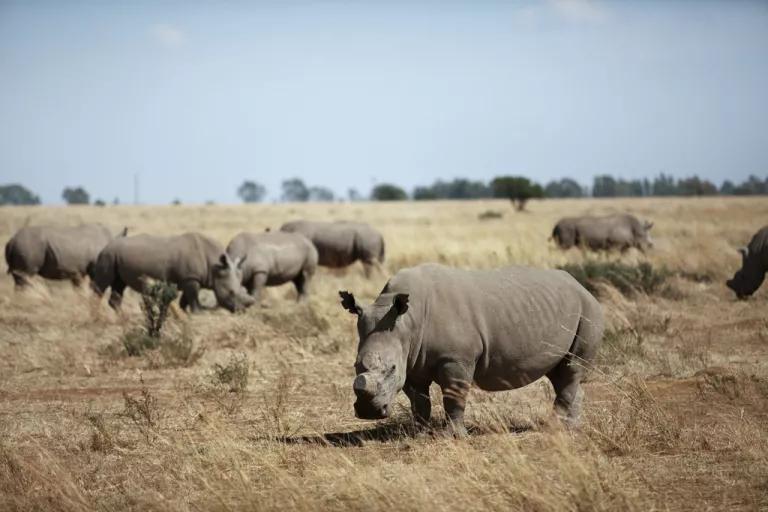
De-horned white rhinos on Hume's Buffalo Dream Ranch
Back at the Buffalo Dream Ranch, Hume took me for a drive. He pointed out a grazing pasture for rhinos that lay fallow in the distance, and here and there we caught glimpses of his zebras and impala. A farmer and entrepreneur at a young age in Rhodesia, Hume amassed enough money to buy his own farm in his late teens. He fled in 1974 and lived for a couple of years in South Africa, where he was born. In the late ’70s he spent some time in the United States, settling in Boothbay Harbor, Maine, for a few years and opening a shop that sold African arts and crafts. But he eventually found his way back to South Africa, and back to farming animals.
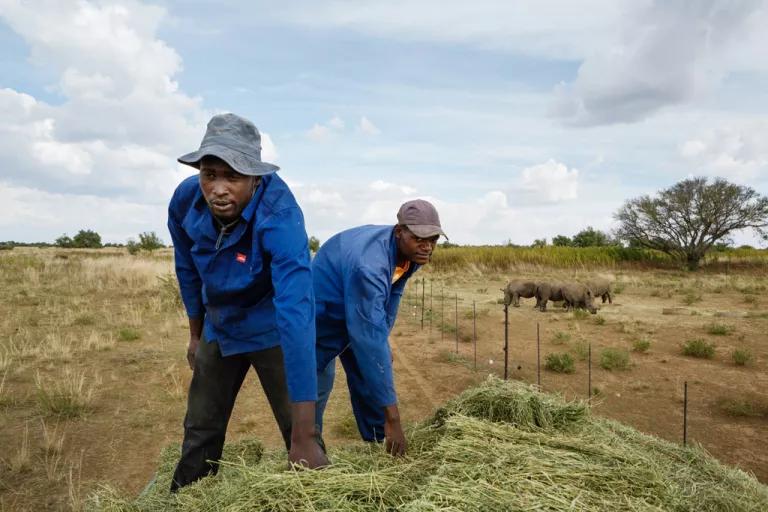
Tafadzwa Mhosa (left) and Eric Ndlovu feed rhinos by tractor at Buffalo Dream Ranch.
None of the rhinos on Hume’s ranch has a full horn on its nose—in place of each horn is a stump. Hume saws off and saves the horns, making the rhinos less attractive to poachers. But enough of each horn gets left behind that, at today’s prices, poaching is still a threat. Poachers, of course, are not interested in long-term harvesting—they simply kill the animals, then take an axe to their faces to dig the entire horn out from the skull so they can deliver it for payment. The horns get smuggled to Asia, and the poachers get back to work.

De-horned rhinos at Buffalo Dream Ranch
Rhino breeders—with their stockpiles of harvested horns—stand to make tens of millions of dollars if trade is legalized. Hume owns four tons of horn, which he estimated would earn him about $40 million at current prices. (After filling up the local banks with his stock, he now keeps them with an international security firm.) “The majority of that money would go into protecting the rhinos,” he said, “and the rest into breeding.”
Hume has bred more than 500 rhinos to date, including 131 in 2014. His goal is to produce 200 calves a year, at which point he could start selling the animals. His ultimate ambition is to buy more farmland and increase the scale of his operation, so that in the next 20 or 30 years—“If they ever get rid of the scourge of poaching”—he could release his rhinos back into the wild.
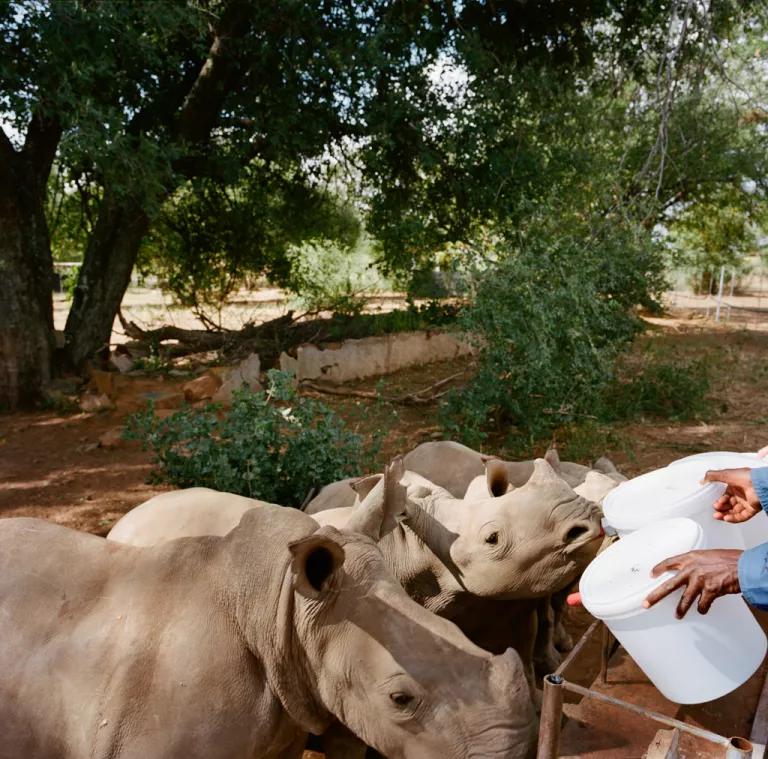
Baby white rhinos being fed at Buffalo Dream Ranch
We drove back to the main house, where more members of Hume’s anti-poaching unit sat silently in the shade, awaiting their polygraph. “Rhinos today are worth more dead than alive,” Hume said, adding that if trade were legalized, the animals would have more allies than ever. “Nobody would ever kill a rhino if he was getting money from the horn.” A smile spread across his face, and he cupped his hands together as if holding an imaginary prize: “It produces like a hen—and who the hell would kill the hen that lays the golden egg?”
* * *
I met up with Vincent Barkas on a sparkling day in Hoedspruit, a town in eastern South Africa, just outside of Kruger National Park. He’d been out all night on patrol, and his long graying hair was pulled back from his face with a baseball cap. Barkas runs ProTrack, one of the country’s premier wildlife-security companies, which he founded in 1992 after he got out of the army.
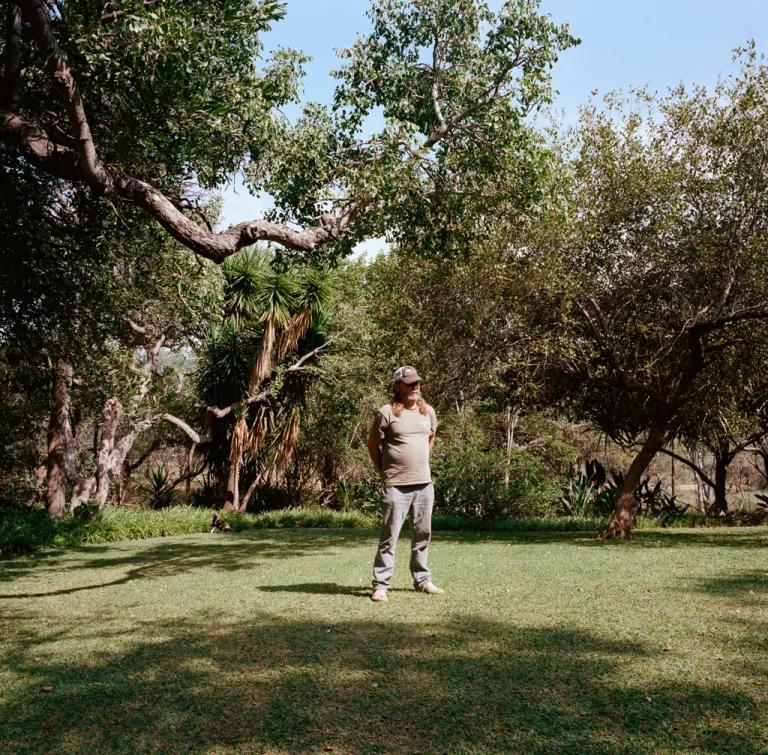
Vincent Barkas, owner of the security firm ProTrack
ProTrack’s clients are largely private game reserves in the Kruger area, where wealthy tourists pay top dollar to be pampered in the African wilderness while getting an up-close look at the area’s legendary wildlife. Most of the poachers Barkas is fighting come from Mozambique, South Africa’s neighbor to the east, which shares a 220-mile border with Kruger Park. Mozambique’s villages along the border are desperately poor, and the temptation to kill the rhinos just beyond the fence line is one many can’t resist. “The poacher is viewed as Robin Hood, stealing from the rich and giving to the poor,” said Barkas. He’ll use his rhino horn profits “to build a shop, drive someone to the hospital, loan money—doing things the community sees as good.”
But the influx of money has had corrosive effects as well. In Massingir, a town in Mozambique just a few miles from the Kruger border—a place Barkas calls the “poaching capital” of the region—rhino horn profits have sparked a rise in prostitution, cocaine use, and the deadly combination of alcohol and untrained new car owners. “What was a very communal place is now divided,” Barkas told me. “They’re killing each other, and organized crime has moved in.”
Considering the boon for the security industry that has come from the rise in poaching—and the promises from the pro-trade lobby to spend future horn profits on more security—you might think Barkas would be pro-trade. Not so. “It’s a racket,” he said. “The people for legalization are those who stand to make money from it. How much are they going to put back into conservation? Nobody knows.”
More importantly, legalization would spark an increase in demand. As Andrew Wetzler, director of the Land and Wildlife program at NRDC (disclosure), told me, “Given the experience the world has had with the one-off sales of ivory, we ought to be extraordinarily cautious when it comes to rhino horn legalization. The only argument in favor of it is that it will bring down the price and therefore reduce the incentive to poach. And I don’t think there’s any reason to think that’s true.”
“The killing of people must stop,” Barkas said. “Then the killing of rhino will stop.”
According to Wetzler, there are two main reasons why legalization won’t work. First, if trade were allowed, it would become much easier to buy and sell illegal rhino horn, with criminals fraudulently applying legitimate certificates to contrabands, making it difficult to distinguish one from the other. Second, the demand for horn is so high—and could potentially get much higher in China and Vietnam if made legal—that they can’t be produced fast enough to affect the price.
“If you can’t drive the price down, then all you’re doing is generating a new market. And as long as the price is extraordinarily high, there’s every incentive to poach,” Wetzler said. “So rather than alleviate the problems, it’s very likely that legalization will just make it worse."
Adam Welz, who represents South Africa for WildAid, a nonprofit that fights illegal wildlife trading, agrees: “The second you legalize it, you’re sending a very powerful message. You’re endorsing this product—and you’re immediately going to get a lot more people interested in buying it.”
Welz puts no stock in the idea that rhino horn revenue could pay for sufficient security, pointing out that protecting some rhinos in a “prison camp” situation, with giant electric fences and machine gun posts in every corner, isn’t enough. “You’re never going to protect them in an ecologically functional way,” he said. “You’re always going to find somebody willing to risk his life to shoot a rhino because he’s going to get paid five or ten times his annual salary for two days work.”
The crux of the problem, from Welz’s perspective, is a lack of political will by the South African government to do what’s really necessary to fight the poaching war: strengthen basic law enforcement, including prosecutorial competence, and involve more citizens in rhino and wildlife issues through education and real economic opportunity. Progress can also be made in efforts to reduce demand in Asia.
What’s most frustrating for Welz, however, is that the argument over legalization shouldn’t even be on the table. Even if trade were legalized, it would take years for the necessary framework to be put into place, and if poaching continues to escalate at its current pace, “we can kiss wild rhinos good-bye,” said Welz. “How on earth do you get a proper system up and running in a time frame that’s actually meaningful for rhinos?” The entire debate “is just a waste of time.”
* * *
Damien Mander, a former commando from Australia who founded the International Anti-Poaching Foundation, or IAPF, in 2009, believes the international community should fund the protection of the rhino, which he calls a “global asset.” Until that happens, he says, South Africans will look to alternate solutions like legalization to pay for security against “what is essentially an insurgency.” So, in the meantime, IAPF trains anti-poaching units in South Africa, Mozambique, and Zimbabwe—stopgap security measures to halt the hemorrhaging while long-term solutions can be found.
Mander doesn’t expect the South African government to make any moves to end the poaching crisis until after the legalization issue is resolved. If the government were to halt poaching, he says, CITES would no longer need to consider legalization. “But if that were to happen, South Africa would stand to lose the sale of the 30 tons of stockpiled rhino horn,” Mander says. “Who the hell wants to give up on a billion-dollar investment?”
Even if trade were legalized, it would take years for the necessary framework to be put into place, and if poaching continues to escalate at its current pace, “we can kiss wild rhinos good-bye,” said Welz. The entire debate “is just a waste of time.”
In Hoedspruit, Vincent Barkas’ views on security and conservation have changed over the years. Coming from a “spoiled” white apartheid–based upbringing, he believed when he started ProTrack that poachers should be shot. “Black people were bad,” he said. “They were the reason we were losing all our wildlife.”
In South Africa, wildlife is a rich white man’s thing. “We’ve excluded black people from being part of it,” said Barkas. He’s tried to close that gap by incorporating community-education programs into his anti-poaching work—but they’re hard to finance. “Ask for a donation for pens and paper to go sit with children and write and teach—nobody wants to hear that,” he said. “But go ask for funding for 10 guns. Oh, yes, you want to kill people! Here are more fucking guns, go for it!”
Barkas has grown to understand the limitations of violence in the security business. The more poachers he caught over the years, the more he saw himself as a “bully.” Had he grown up poor, he realized, he probably would be a poacher.
But a more nuanced approach is not usually in the DNA of those fighting poaching, and as the well-armed security industry continues to breed resentment among the poor, rhinos and other wildlife are taking a huge hit as well. “When you kill that poacher, you turn an entire community against conservation,” said Barkas, who described how some of his greatest successes fighting poaching have come when he left his weapons at home and took the time to listen to the poachers’ side of the story. “We’ve got to sit with them and say all right, what’s the road forward? When the rhino are gone, what are your children going to do?”
It might be too late for rhinos, but what comes next? Many fear that other animals will be targeted once rhinos are gone. Guns will always play a role in the protection of wildlife, but guns alone won’t solve the problem. “The killing of people must stop,” Barkas said. “And then the killing of rhino will stop.”
* * *
Another example of nonlethal efforts to curb poaching is a group called the Black Mambas, an anti-poaching unit based at the Balule Private Game Reserve, a few miles north of Hoedspruit. Comprised of 26 women from local communities, the Black Mambas were formed in 2013 in response to the area’s sharp increase in poaching. “When I heard on the radio every day that rhinos were being killed, it was painful in my heart,” said Collet Ngobeni, dressed in military-style fatigues at the Balule ranger headquarters. “I decided I had to go out and fight for the wildlife.”
About an hour after sundown one evening in late April, I climbed into a Land Rover with Stefan Bosman, a ranger at Balule and one of the Black Mamba supervisors, and two of the team’s women as they headed out on a night patrol. What used to be a staff of one anti-poaching worker doing his rounds on a bicycle has become a far more sophisticated operation in recent years, with multiple teams of rangers, beefed-up fencing, hidden cameras, and drones. But the Black Mambas are usually unarmed, and there were no guns in our patrol truck.
The women, who are staunchly anti-legalization, are trained in far more than just anti-poaching—they know every plant and the habitat of every animal, they’ve marched along every fence line, and they help maintain all the equipment. “When something goes wrong, they take it personally,” Bosman said. “They’ve got a sense of ownership, and that’s what we’re aiming for.”
In March, three rhinos were killed in Balule, the first rhino poachings in a year; before that, the reserve was losing one rhino every four weeks. But the Black Mambas are perhaps proudest of the impact they’re having on the children that come to visit them on school trips. “The kids see the elephants and hear the lions—it’s a three-dimensional experience they’ll remember for the rest of their lives,” Bosman said. “We’re building little conservationists.”
We stopped to check on a fence gate. The moon glowed overhead. “If we didn’t protect the rhinos, the younger generation would never know about them,” said Nomuntu Mogakane, a 25-year-old Black Mamba who wants to go to college to study environmental science. “Since I was young, my dream was to come and work here—in the reserve.”
There is hope, perhaps, in these initiatives that are just out of earshot of the clatter of the security industry and the raucous battle over legalization—these earnest and underfunded efforts to protect a species and knit together a society all at once. Elsewhere, though, conservationists seem to have thrown in the towel on South African rhinos, instead pouring all their energy into slipping the creatures to safety by getting them out of the country altogether.
* * *
Phinda Private Game Reserve—established in 1992 on what was a mix of hunting grounds, cattle ranches, and pineapple farms—lies south of Kruger, on a hook of land that curls around Swaziland and runs into the Indian Ocean. In late April of this year, an organization called Rhinos Without Borders used Phinda to launch an airlift project—an effort to fly rhinos from South Africa to Botswana, which has a “shoot to kill” policy toward suspected poachers, a far more draconian practice than South African law allows.
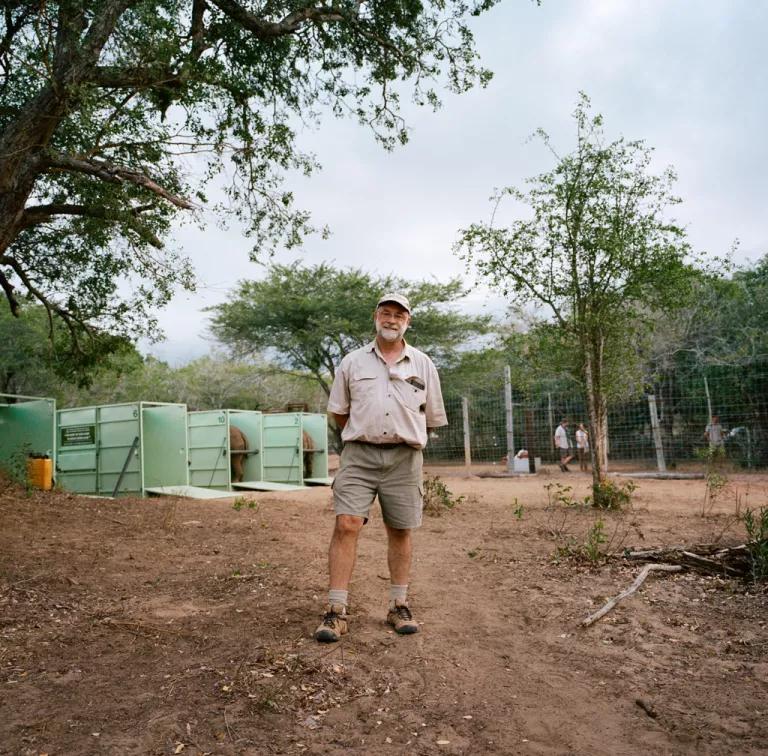
Les Carlisle, project manager for Rhinos Without Borders and conservation manager of andBeyond at Phinda Private Game Reserve, where a group airlifted rhinos to safety, to Botswana
“We’re pumping significant amounts of money into anti-poaching and security and intelligence operations, and yet we’re losing three rhinos a day in South Africa,” said Les Carlisle, the project manager. “So moving the rhinos away, spreading the risk, is a critical part of the current threats we’re facing.”
Phinda’s security is better than most; the reserve hasn’t lost a rhino since October 2013. But in some of the neighboring properties, the story is very different. Mike Toft, a veterinarian, told me that a nearby reserve lost a dozen rhinos between November 2014 and April 2015. According to him, the region is losing between five and ten rhinos a month, and he attends to the remains of every dead animal. “It’s soul-destroying,” Toft said.
We were gathered in a large pen, where ten rhinos had been living for six weeks in preparation for the airlift. (Watch the entire airlift process, narrated by photographer Peter DiCampo, in the video below.) I watched as the first eight were tranquilized, blindfolded, and led by rope to their steel containers without much trouble. Then it started to rain. We drove slowly after the last two rhinos, which eyed us nervously and paced along the back fence. Toft darted one with his tranquilizer rifle, but his next shot glanced off the hide of the other rhino, which grew increasingly agitated as we retreated to prepare another dart. It was raining hard by the time the second rhino was finally shot, and before the drugs could take full effect, the animal staggered dangerously close to a group of us. Carlisle, unfazed and calm, walked over and placed a comforting hand on its neck, then secured a blindfold over its eyes.
It was dark as Carlisle’s team loaded the last of the containers onto the trucks that would take the rhinos to the airport in Durban—the first 10 of what Carlisle hopes will be 100 rhinos transported to safety in Botswana. “For rhinos to survive, we have to make them worth more when they’re alive than when they’re dead,” said Carlisle, who supports trade legalization, believing that horn harvesting is the best way to make people value the species. But it needs to happen soon, he says. If the skeptics are right and several years are needed to establish a workable system, the population will likely be too small to sustain it: “Trade is no longer going to be an option, because there’ll be so few rhinos that you can’t risk trading.”
Once they got to Botswana, Carlisle and the rhinos were met by 50 members of the national defense force and a team from Great Plains Conservation (which shares management of Rhinos Without Borders with andBeyond, Phinda’s parent company). Their convoy to the release site in the Okavango Delta was 20 vehicles long. It was dusk when they finally let the rhinos go.
“Two of the bigger ones gave us a bit of snorting and bouncing around, until they saw they were free. Then they sniffed the grass and started grazing,” Carlisle told me a few weeks later. Four of the rhinos decided to spend the night in a pen that had been set up at the release site. The next morning, Carlisle put out some alfalfa. “They were feeding on the alfalfa, which we put on a line heading out of the gate. And once they got to the end of it they just carried on,” he said. “And strolled into the delta.”
* * *
Airlifting rhinos to safety is one way Phinda is trying to handle the poaching problem, but the reserve also works to spread environmental education at the Nkomo Primary School, in the nearby community of Mnqobokazi (population: 11,000). Phinda began working with the school in the late 1990s, helping to construct some of the classroom buildings, whose white walls are now covered in colorful paintings of African wildlife.
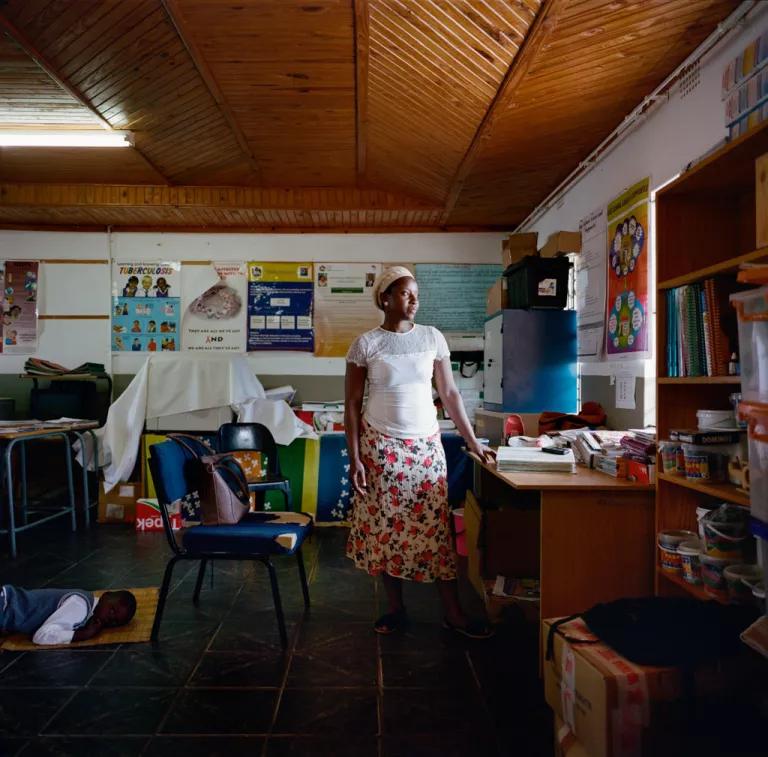
Thunder Myeni, deputy principal of Nkomo Full Service Primary School in Mnqobokazi, South Africa
Phinda conducts school game drives, allowing the children access to wildlife in a way that is normally far too expensive for them, and helps older students seek funding to go to college. “Now they understand the economic value attached to the rhino,” said Thanda Myeni, the school’s deputy principal. “Before, people thought these white people were taking our land and we don’t benefit. But they have learned that conservation is for a good cause. Their children are sent to college and find work, then they support their families in return.”
Myeni showed me textbooks in math, science, and English that incorporate lessons about rhinos and other wildlife. Killing a rhino only benefits the poacher, she said. “But helping a child go to college is a lifelong process. It helps the child and the parents and the community till they die. This is how education has changed the mindset of the community—if you’re hurting a rhino, you’re hurting me.”
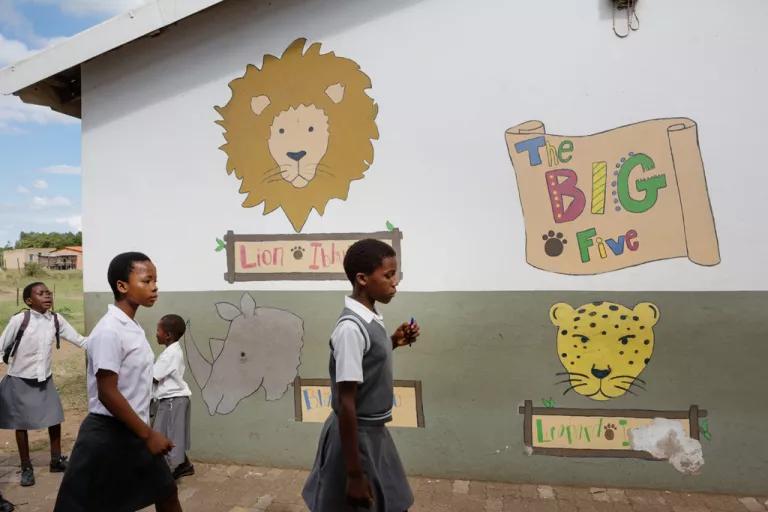
Nkomo Full Service Primary School in Mnqobokazi, South Africa
* * *
The CITES conference in Johannesburg is still nearly a year away, so there is plenty of time for the landscape to shift before any decision on trade legalization is made. In June, in what may be an indication of the pro-trade lobby’s broader tactics, rhino farmers in South Africa took the government to court in an effort to lift the ban on the domestic rhino horn trade, which was outlawed in 2009. Then in July, a group of scientists at the University of Washington successfully crowdfunded a genome-sequencing project they say will allow them to manufacture synthetic rhino horn that is nearly identical to the real thing. But any attempts to flood the market with the fake version would introduce the same supply and demand problems that already undermine the trade-legalization argument.
Rhinos are not the rarest animal species in Africa, but at the rate they’re being killed, they may be heading to extinction faster than any other. And considering the animal’s distinction as one of the continent’s Big Five, their survival is critical not just in the realm of conservation and science but in tourism and economics, as well.
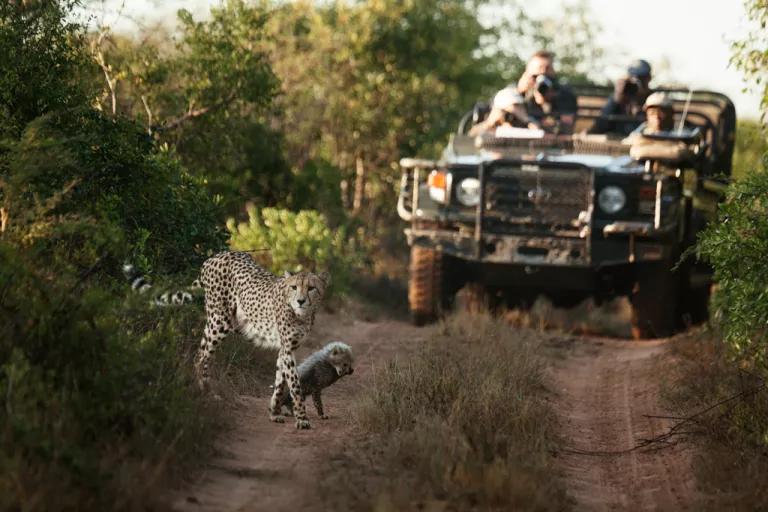
A cheetah mother and her cub at Phinda Private Game Reserve
The day after the rhino airlift, we went for a safari drive at Phinda and saw multitudes of wildlife, including giraffes, leopards, elephants, cheetah, buffalo, and a lion with a freshly killed impala. We didn’t see any rhino until the very end of the day, when a mother and her calf appeared in a clearing amid acacia trees as the sun sank into dusk.
The two beasts paid us little mind as we watched them wander off. “I can’t believe people kill those rhinos for their horns—if that mother gets killed, the baby will never survive,” said a man sitting in front of me. “The brutality of it—people say, ‘Oh, my kids won’t get to see them if they’re killed off,’ but that’s not even it.
"It’s an animal, and it deserves to live.”
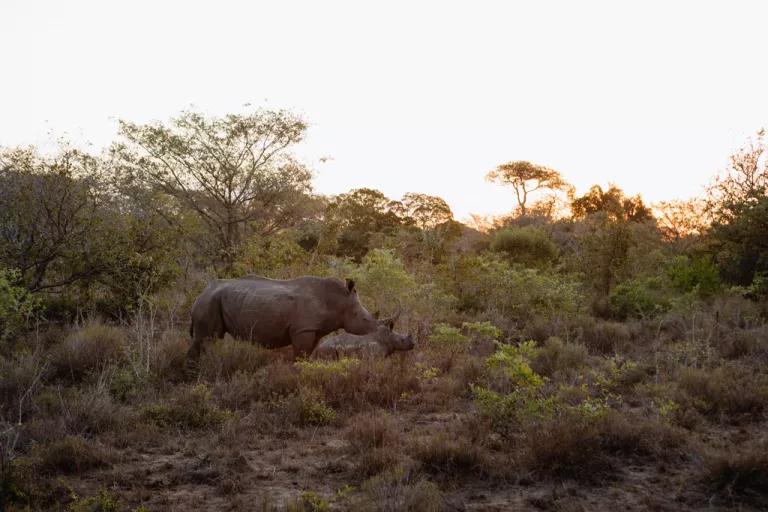
An adult rhino and her calf at Phinda Private Game Reserve
This article was originally published on onEarth, which is no longer in publication. onEarth was founded in 1979 as the Amicus Journal, an independent magazine of thought and opinion on the environment. All opinions expressed are those of the authors and do not necessarily reflect the policies or positions of NRDC. This article is available for online republication by news media outlets or nonprofits under these conditions: The writer(s) must be credited with a byline; you must note prominently that the article was originally published by NRDC.org and link to the original; the article cannot be edited (beyond simple things such grammar); you can’t resell the article in any form or grant republishing rights to other outlets; you can’t republish our material wholesale or automatically—you need to select articles individually; you can’t republish the photos or graphics on our site without specific permission; you should drop us a note to let us know when you’ve used one of our articles.






A Leader for Conservation in Gabon and Beyond
Status Check for African Elephants
Rhino Horns Are Basically Just Giant Toenails. And These Images Won’t Let You Forget It